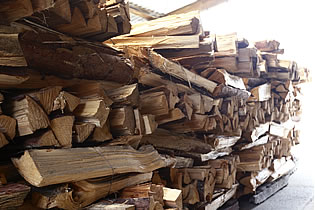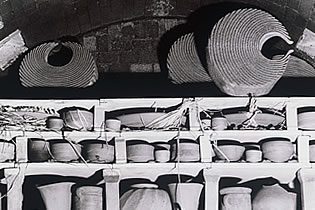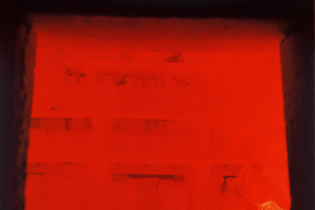History of Bizen ware
Bizen ware is from a region of western Japan facing the Seto Inland Sea. This is one of the six remaining kilns from the medieval period. Bizen ware is the oldest of the six, descended from Sue ware. Bizen ware has a history of more than one thousand years.
Bizen ware uses high temperatures and depending on the conditions of firing and the kiln, the colors are enriched. Bizen ware has its own unique rustic simplicity. It is cherished by potteries lovers both in Japan and abroad.
Bizen ware became prominent in the Azuchi-Momoyama era as the tea ceremony became popular across Japan. It was also used for everyday use as water pots and mortars.
During the Showa Period (1926-1989), Bizen ware pottery became popular again because of Living National Treasures like Toyo Kaneshige, Kei Fujiwara, Toshu Yamamoto who polished it.

Pine Tree

Placement into Kiln

Baking in the Kiln
Characteristic of Bizen ware
The characteristics of Bizen ware are its hardness, color, and absence of glazing. Bizen ware is fired in a wood-burning kiln at high temperatures and results in effects called yohen. The prominent kiln effects are goma (sesame seed) and hida. Goma is an effect from the pieces having pine ash on them during firing. Hida is a kiln effect produced because of straw wrapped around the pieces. Bizen ware takes on different qualities as it is used over time. The simplicity of Bizen ware holds interest and is timeless. Because it does not have a glaze and is air permeable, water stays fresher longer. This quality makes Bizen ware ideal for water urns or vases. Nowadays, Bizen ware is used for serving beer and wine. Bizen ware is said to enhance the flavor of cuisine.
Use of Bizen ware
·Use as same as usual dishes.
·Dip in a water before use to prevent smells or oils from food penetrating the product.
·Sudden change of temperature may damage.
·Avoid pouring hot water into the ware suddenly.
·Use another container to make hot sake then use the Bizen ware to serve.
·Avoid using a microwave or dish washer.
·Wash as usual after use and dry well.
·Because it doesn't use glaze, the surface is not smooth.
·It may damage tables or shelves, use a cloth.
·We check the leaks of product, but flower vases might stain floors.
·Bizen ware is strong but keep it in a safe place in case of an earthquake.
·It absorbs moisture so, do not leave in water, wash quickly and dry well.
![]()
·
Bizen-yaki (ware)
It originated in Bizen City, Okayama Prefecture. It is one of the six oldest kilns in Japan. It is mostly produced in the Imbe area of Bizen City, it is called Imbe-yaki as well.It does not use glaze. Baked with high temperature around 1250 celsius degree. The characteristic of Bizen ware is caused by Yohen (Kiln Effects). The finish will differ and each product has unique pattern. Bizen ware produced before the Edo era are called Ko-Bizen and they are valuable.
·
Six Remaining Kiln
The oldest style of Japanese kilns. Other than Bizen, there are Tanba, Sigaraki, Seto, Tokoname, Echizen.
·
Living National Treasure
Government appointed individuals who are held as important intangible cultural assets. For Bizen ware, Toyo Kaneshige, Kei Fujiwara, Toshu Yamamoto, Yu Fujiwara, Atsushi Isezaki are designated.
·
Okayama Prefectural Living Treasure
For the craftmanship , Masami(Seihou) Kakumi, Tomoyuki Matsui, Yuuichi Yamamoto, Saizou(Tougaku) Mori, Tadashi Yoshimoto, Kousuke Kaneshige, Izuru Yamamoto are designated.
·
Earthenware and Ceramic
Clay of earthenware does not contain feldspar and called 'Tsuchimono'. Shigaraki, Hagi, Bizen wares are classified as earthenware.
The main components of ceramics are rich in feldspar and called 'Ishimono'. The finish of ceramics are white and the surface resembles glass. Mino, Imari, Seiji and Hakuji of China and Korea are examples.
·
Yohen
·
Guinomi
A term used to describe a way of drinking sake in one big gulp. It is bigger than a Ochoko cup, smaller than Chawan cup.


Unpredictable kiln effects. Bizen ware uses them on purpose to make unique patterns and colors.
「San-giri」……The potteries placed on the bottom of the kiln buried by ash and fire can not directly contact making them oxidized and colorize the pieces grayish blue, dark gray or gold.
「Botanmochi」……Placing other products like cups onto dishes to avoid the fire and makes red or white colored patterns.
「Goma」……Ashes of pine trees make rough surfaces like Goma (sesame seeds).
「Hidasuki」……To avoid the contact with the next product, straw is used which causes a chemical reaction resulting in dark blue lines.